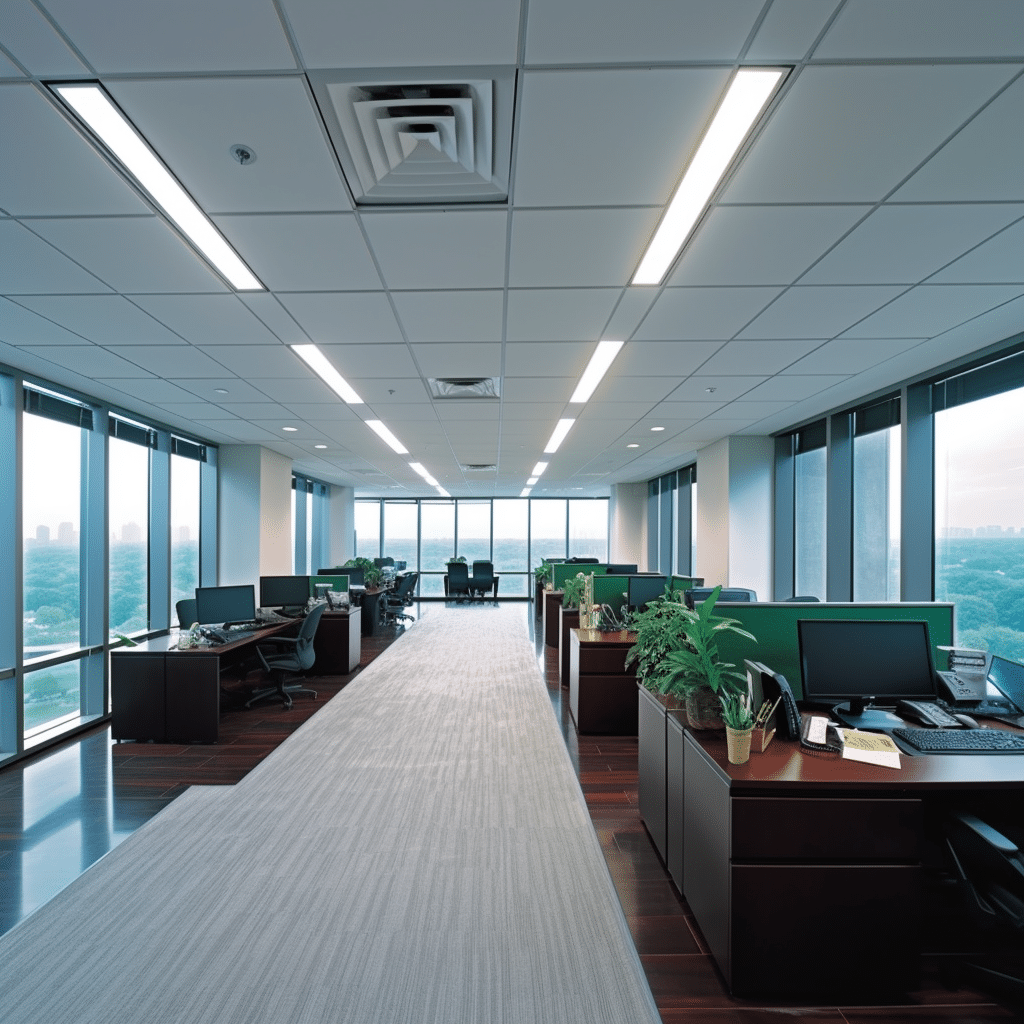.jpg)
Table of Contents
Introduction to Lighting Control Systems
Lighting control systems offer lots of benefits when used in residential and commercial spaces. They let users control light intensity, color, and timing. Also, they work with other smart home tech for a personalized experience.
Energy efficiency is one of the key advantages. Systems can adjust lighting levels automatically, based on occupancy or daylight. This saves energy and money.
Plus, the systems make living and working environments more comfortable. Lights can be dimmed or brightened to fit personal preferences. Color-changing capabilities provide creative customization for special occasions.
To get the most out of lighting control systems, it’s important to follow some advice. Use LED bulbs – they use less energy and are better quality. Put in motion sensors so lights only come on when needed. Program lighting schedules to switch off during unoccupied hours. And, integrate with voice-activated assistants or apps for easy control.
Types of Lighting Control Systems
Lighting control systems are essential for managing and regulating illumination in various settings. They provide flexibility, convenience, and energy efficiency. Different types of these systems let users optimize lighting conditions to create desired ambiances.
Let’s explore the various types:
- Manual Control Systems: Let users manually adjust lighting settings using switches or dimmers. Controls individual lights or groups of lights.
- Automatic Control Systems: Utilize sensors to detect natural light levels or occupancy. Automatically adjust lighting, optimizing energy usage.
- Time-Based Control Systems: Enable users to set specific times for lights to turn on or off. Particularly useful for outdoor lighting or areas with predictable usage patterns.
- Centralized Control Systems: Centralize management of multiple lighting zones or areas from a central location. Offer convenience and ease in controlling different aspects of lighting across large spaces.
- Distributed Control Systems: Distribute control functions across multiple devices or locations. Allow for efficient management and customization.
- Networked Control Systems: Connect devices and components through a network infrastructure. Seamless communication and integration with other building management systems.
- Daylight Harvesting Systems: Utilize daylight sensors to effectively balance natural light with artificial light sources. Reduce energy consumption while maintaining appropriate illumination levels.
- Wireless Control Systems: Eliminate need for physical wiring by utilizing wireless technology such as radio frequency (RF) signals or Bluetooth connectivity. Allows remote control of lights.
- Energy Management Systems (EMS): Focus on optimizing energy consumption by integrating lighting controls with other building automation systems, like HVAC.
- Interactive Control Systems: Let users control lighting settings through interactive interfaces like touchscreens or mobile applications. Offers an intuitive and interactive user experience.
The lighting industry has been revolutionized by technology advances. We can now efficiently manage energy usage while creating desired environments. No more disco parties in the kitchen!
Benefits of Lighting Control Systems
Lighting control systems offer many advantages that bring both convenience and efficiency. With the power of advanced technology, users can control their lighting needs like never before.
Energy Savings: Automatically adjust lighting levels based on occupancy and daylight to save energy and money.
Enhanced Comfort: Easily customize lighting levels to create personalized environments for comfort.
Increase Lifespan: Reduce running time of lights to extend bulb lifespan, saving maintenance costs and reducing waste.
Security Integration: Integrate with security systems to enhance safety measures, like creating an illusion of occupancy or synchronizing with alarm systems.
Simplified Maintenance: Centralized monitoring simplifies management and maintenance of lighting infrastructure to reduce downtime.
Flexibility: Adjust settings according to changing needs for optimal performance.
Don’t miss out on the many benefits of cutting-edge lighting solutions – enhanced convenience, cost savings, security, sustainability, and well-being. Upgrade your lighting system today! Brighten up your space – installing a lighting control system is like having your own personal sun dial without the risk of any ancient curses.
Implementation and Installation of Lighting Control Systems
Lighting control systems are vital for creating personalized lighting environments. To install them, follow these three steps:
- Assess your needs: Estimate the size of the space, desired automation level, and any special lighting features you want. Use this assessment to select the best system for you.
- Choose the right system: Research systems in the market with features that match your requirements, such as programmable settings, bulb compatibility, energy-saving, and ease of use. Pick one with the perfect mix of features and flexibility.
- Professional installation: Hire an expert for an optimal outcome. They’ll ensure all components are connected and integrated, calibrate the system to your preferences, and troubleshoot any potential issues.
Additionally, when implementing, consider this:
- Adequate planning: Plan the positioning of lights and controls in advance, for better integration with existing fixtures or modifications.
- Thorough testing: Test the system before finalizing setup. Check if lights respond to sensors or user interfaces. Address any glitches or inconsistencies as soon as possible.
- Regular maintenance: Maintain the system for long-term performance and reliability. Inspect it yearly for wear and tear or outdated components that may need replacing or updating.
By following these steps and suggestions, you can install lighting control systems that meet your needs while improving the space’s aesthetics and energy efficiency. From disco parties to werewolf mood lighting, these systems have lit up many experiences.
Case Studies: Successful Lighting Control System Implementations
Case studies on successful lighting control system implementations provide insight into the many benefits these systems bring to various industries. One such study saw a commercial office building reduce energy use by using occupancy sensors and daylight harvesting.
A healthcare facility integrated their control system with their existing building automation, providing better lighting quality and customization in patient rooms.
Another case study focused on a retail store, where dimming controls created different atmospheres throughout the day, increasing sales potential.
These success stories prove investing in lighting control systems can result in energy savings, comfort, reduced maintenance costs, and increased productivity.
Organizations of all sectors can benefit from advanced technology and smart control strategies, leading to sustainability and improved operations. The future of lighting control systems is looking bright!
Future Trends and Innovations in Lighting Control Systems
Lighting control systems are advancing fast, with amazing new trends and innovations! Here are four key points to note:
- Adaptive lighting: Sensors can now change the brightness and color temperature of lighting, based on the environment. This means better user comfort and reduced energy use.
- Smart integration: Voice assistants and motion sensors can now be connected to lighting control systems. This makes personalizing atmospheres easier than ever!
- Wireless connectivity: No more complicated wiring setups. Wireless systems are becoming more popular, making installation simpler and enabling remote monitoring and management.
- Data-driven optimization: Data analytics are being used to optimize energy consumption. These systems can identify ways to save energy without sacrificing comfort or looks.
But wait, there’s more! Artificial intelligence is also being used in lighting control systems. AI-powered lighting can adjust to preferences over time, creating tailored environments for each individual.
Let’s take Thomas, an office worker who was having trouble concentrating due to poor lighting. He discovered a new system that changed the light levels based on daylight and his own preferences. This simple solution improved his focus and productivity!
As we look forward, it’s clear that innovation will keep redefining lighting control systems. Adaptive features, smart integration, wireless connectivity, and data-driven optimization will open up exciting possibilities. Embracing these advancements will improve our daily experiences and create a brighter, more efficient future.
Conclusion: Harnessing the Power of Lighting Control Systems
The power of lighting control systems is undeniable. These systems provide multiple advantages that can upgrade any space. Here are the main points that emphasize the significance and possibility of lighting control systems:
- Energy Efficiency: Lighting control systems enable efficient energy usage by allowing users to adjust and customize lighting levels. This lessens wasted energy consumption and lowers electricity bills.
- Enhanced Ambiance: With lighting control systems, you can create various atmospheres in a room through dimming, color-changing, and scene-setting features. This adds a personal touch to any environment.
- Sustainability: By encouraging energy-saving habits, lighting control systems help create a greener future. They can also integrate with other building automation systems for extra sustainability efforts.
- Increased Comfort: Lighting control systems provide the flexibility to adjust lighting levels according to personal preferences or specific tasks. This ensures ideal comfort for occupants while minimizing eye strain.
- Improved Productivity: Brightly lit spaces have been proven to positively influence productivity levels. Lighting control systems help create well-lit environments that foster concentration and focus, boosting overall work performance.
- Cost Savings: Although the initial investment in a lighting control system may seem large, the long-term savings make it worthwhile. Lower energy consumption and maintenance costs result in notable financial benefits over time.
Apart from these key benefits, there are some unique details about lighting control systems. For example, wireless technology now makes it easy to install and operate these systems without complex wiring or extensive retrofitting.
Don’t miss out on these incredible advantages. Consider integrating a lighting control system into your space. Enjoy increased comfort, efficiency, and personalized ambiance firsthand. Don’t let outdated lighting solutions prevent you from accessing the power of lighting control systems. Upgrade now and unlock the full potential of your space.

